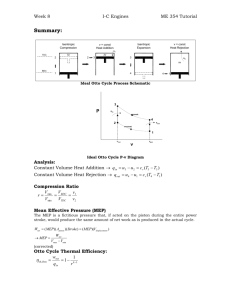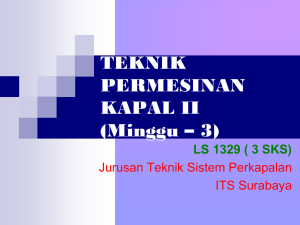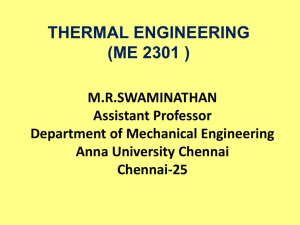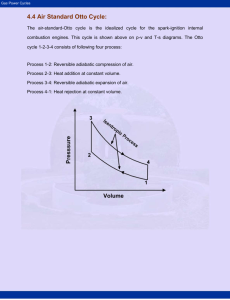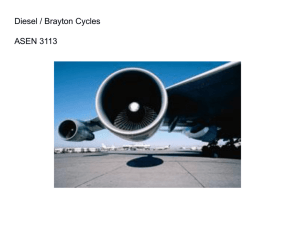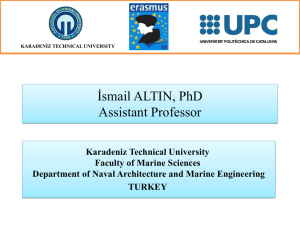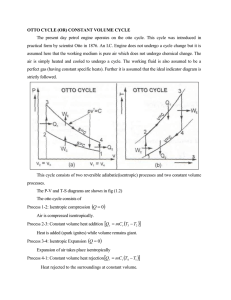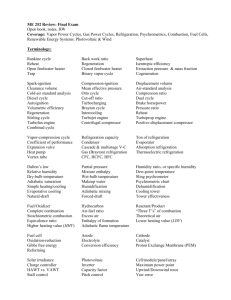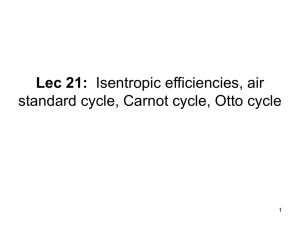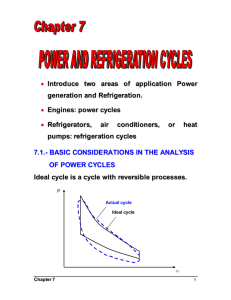Gas Power Cycles
advertisement
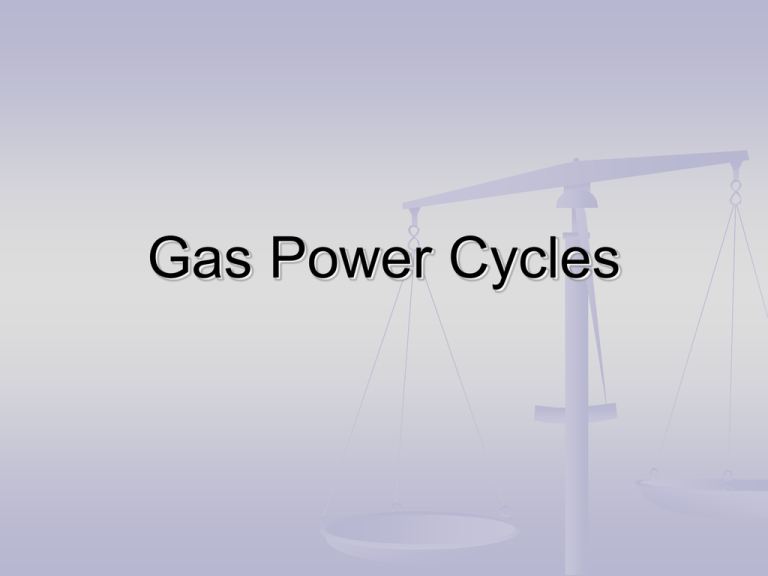
Gas Power Cycles Power Cycles Ideal Cycles, Internal Combustion Otto cycle, spark ignition Diesel cycle, compression ignition Sterling & Ericsson cycles Brayton cycles Jet-propulsion cycle Ideal Cycles, External Combustion Rankine cycle Modeling Ideal Cycles Idealizations & Simplifications Cycle does not involve any friction All expansion and compression processes are quasi-equilibrium processes Pipes connecting components have no heat loss Neglecting changes in kinetic and potential energy (except in nozzles & diffusers) Carnot Cycle Carnot Cycle Gas Power Cycles Working fluid remains a gas for the entire cycle Examples: Spark-ignition engines Diesel engines Gas turbines Air-Standard Assumptions Air is the working fluid, circulated in a closed loop, is an ideal gas All cycles, processes are internally reversible Combustion process replaced by heat-addition from external source Exhaust is replaced by heat rejection process which restores working fluid to initial state Cold-Air-Standard Assumption Air has constant specific heats, values are for room temperature (25°C or 77°F) Engine Terms Top dead center Bottom dead center Bore Stroke Engine Terms Clearance volume Displacement volume Compression ratio Engine Terms Mean effective pressure (MEP) Otto Cycle Processes of Otto Cycle: Isentropic compression Constant-volume heat addition Isentropic expansion Constant-volume heat rejection Otto Cycle Otto Cycle Ideal Otto Cycle Four internally reversible processes 1-2 Isentropic compression 2-3 Constant-volume heat addition 3-4 Isentropic expansion 4-1 Constant-volume heat rejection Otto Cycle Closed system, pe, ke ≈ 0 Energy balance (cold air std) Otto Cycle Thermal efficiency of ideal Otto cycle: Since V2= V3 and V4 = V1 Where r is compression ratio k is ratio of specific heats Otto Cycle Spark or Compression Ignition Spark (Otto), air-fuel mixture compressed (constant-volume heat addition) Compression (Diesel), air compressed, then fuel added (constant-pressure heat addition) Diesel Cycle Diesel Cycle Processes of Diesel cycle: Isentropic compression Constant-pressure heat addition Isentropic expansion Constant-volume heat rejection Diesel Cycle For ideal diesel cycle With cold air assumptions Diesel Cycle Cut off ratio rc Efficiency becomes Brayton Cycle Gas turbine cycle Open vs closed system model Brayton Cycle Four internally reversible processes 1-2 Isentropic Compression (compressor) 2-3 Constant-pressure heat addition 3-4 Isentropic expansion (turbine) 4-1 Constant-pressure heat rejection Brayton Cycle Analyze as steady-flow process So With cold-air-standard assumptions Brayton Cycle Since processes 1-2 and 3-4 are isentropic, P2 = P3 and P4 = P1 where Brayton Cycle Brayton Cycle Back work ratio Improvements in gas turbines Combustion temp Machinery component efficiencies Adding modifications to basic cycle Actual Gas-Turbine Cycles For actual gas turbines, compressor and turbine are not isentropic Regeneration Regeneration Use heat exchanger called recuperator or regenerator Counter flow Regeneration Effectiveness For cold-air assumptions Brayton with Intercooling, Reheat, & Regeneration Brayton with Intercooling, Reheat, & Regeneration For max performance Ideal Jet-Propulsion Cycles Ideal Jet-Propulsion Cycles Propulsive power Propulsive efficiency Turbojet Engines Turbofan: for same power, large volume of slower-moving air produces more thrust than a small volume of fast-moving air (bypass ratio 5-6) Turboprop: by pass ratio of 100 Jets Afterburner: addition to turbojet Ramjet: use diffusers and nozzles Scramjet: supersonic ramjet Rocket: carries own oxidizer Second Law Issues Ideal Otto, Diesel, and Brayton cycles are internally reversible 2nd Law analysis identifies where losses are so improvements can be made Look at closed, steady-flow systems Second Law Issues For exergy and exergy destruction for closed system: For steady-flow system: Second Law Issues For a cycle that starts and end at the same state:

